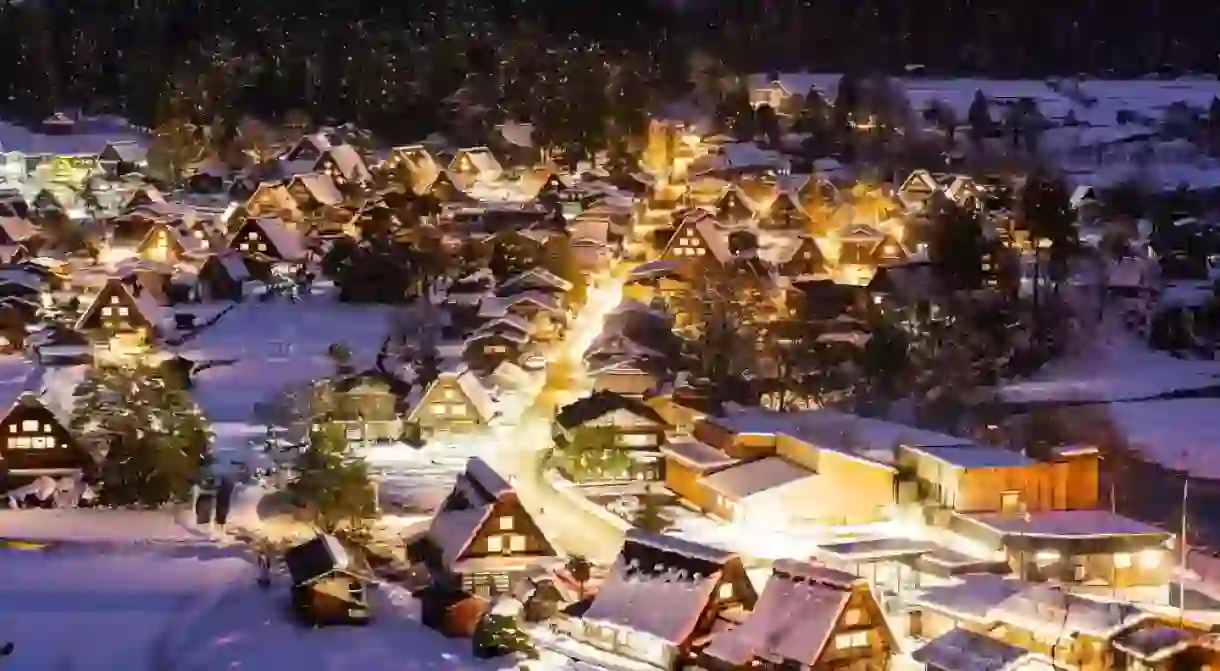The 9 Best Things To Do in Shirakawago

If you’re making a trip deep into the mountains of Gifu prefecture to uncover the whimsical folk town of Shirakawago, you’ll discover a destination that seems out of this modern world. Home to thriving traditional businesses, hot springs and monks, here’s how to do Shirakawago right.
Nestled deep in the mountainous valleys of Gifu prefecture, Shirakawago’s unique townscape in recent times has become a popular adventure destination for those looking to uncover a different side of Japan. Its meticulously maintained thatched-roof houses are worlds away from the concrete and steel skyscrapers of Tokyo, and its lush green surrounds are a great contrast to the paved streets of Kyoto.
It’s a town populated by long-running local businesses and residents who love sharing their passion for tradition and history. Beyond the shops, the town’s natural surroundings are unforgettably beautiful – especially in the middle of winter when the area is dusted in snow. Touching down in Shirakawago, you’ll feel like you’ve stepped straight into the middle of some folktale wonderland.
Sleep in a gassho house
Architectural Landmark

With their thick, woven thatched roofs, the traditional farmhouses of Shirakawago are one of Gifu prefecture’s most recognisable images. When translated, gassho means ‘praying hands’, a reference to the houses’ high-angled roofs that look like a monk’s hands in prayer. These UNESCO-recognised homes are known as minka (houses of the people), a term used in the Edo era (1603-1868) for regular everyday homes. While they’re from humble origins, a stay in a gassho-style accommodation is the most immersive way to get a sense of what it was like to live as a Shirakawago resident. Most accommodation options offer daily meals, too, and as they’re very popular, it’s worth booking months in advance.
Drink exclusive local booze at the Doburoku Matsuri Festival
Architectural Landmark

The Doburoku Festival – an annual event hosted from the end of September through to October – is a local celebration held to pray for a bountiful harvest in the coming year. It gets its name from Doburoku sake, a local sake that’s been passed down through generations and is only enjoyed at this particular time of year. During the event, guests are invited to join in on the folk songs and festivities and hang around until the evening to enjoy an array of dance performances.
Eat hida beef croquettes
Architectural Landmark
The streets of Shirakawago are lined with speciality stores selling traditional snacks and goodies, such as toasted mochi and rice-flour waffles, but there’s another must-try local treat: hida beef croquettes, sourced from nearby Takayama. When it comes to quality, hida beef is on a par with more internationally recognised names such as wagyu and kobe. However, you probably won’t be eating your next wagyu steak ground up with mashed potatoes, deep-fried in batter, wrapped up in a paper pocket and eaten on the go – that’s just how the residents of the Hida region like to enjoy their meat.
Eat soba at Jippensha
Restaurant, Japanese

Soba (buckwheat noodles) are a culinary staple eaten all across Japan, but in regional, mountainous areas like Gifu and neighbouring Nagano, they’re far more special. Water quality is one of the critical components of high-quality soba, and Gifu is overflowing with it. Sitting right by Murakami House – one of the area’s main tourist attractions – you’ll find the humble soba store Jippensha (拾遍舎). The shop serves deliciously rustic and healthy soba noodle dishes, as well as plenty of sides, such as tempura and bean curd.
Stop for cake and coffee at Coffee Shop Hina
Coffee Shop, Japanese

When it’s snowing outside, there’s nothing more satisfying than snuggling up in a cosy wooden lodge with a rich, steamy cup of coffee and a slice of cake for company. Coffee Shop Hina is a traditional coffee shop (known in Japan as a kissaten). You won’t find any fancy frappé blends here, but what you will find is lovingly dripped coffee, a no-fuss homely welcoming ambience, friendly staff and plenty of time to reflect.
Admire the evening view at Ogimachi-jo Castle Ruins Observatory
Natural Feature
While soaking up the sights on street level is a great way to enjoy Shirakawago, take the 30-minute walk (or a 10-minute ride on the shuttle bus) from the town centre to the observatory to get a better perspective of the town’s beauty. From the site – which was once the home of Ogimachi-jo Castle – you’ll have some unforgettable scenes of a place that looks like it’s been ripped straight from the pages of a Japanese folktale.
Take a soak in Shirakawa-go no Yu
Natural Feature

Bathing is taken so seriously in Japan that it’s considered a worthy activity to base an entire holiday around, and when you’ve visited an authentic onsen (natural hot spring), you’ll understand. Shirakawa-go no Yu is the only natural hot spring in the Shirakawago area. Its mineral-rich water contains a lot of sodium, chloride and hydrogen-carbonate ions, which supposedly help with physical ailments like muscle pain, bruises and digestive issues. If you’re at full health, it’s just an excellent way to relax and warm up.
See how local monks live at Myozenji Temple Museum
Museum
Founded in 1748, the Myozenji Temple is home to the largest building in Shirakawago, the ‘kuri’, also known as the monk’s residence. No longer a functioning temple, this site now houses a museum of the temple’s history. It offers insight into how the town’s most dedicated worshippers used to live all those years ago and includes an exhibition space displaying daily items from the past.
Take a detour to Gokayama
Park














